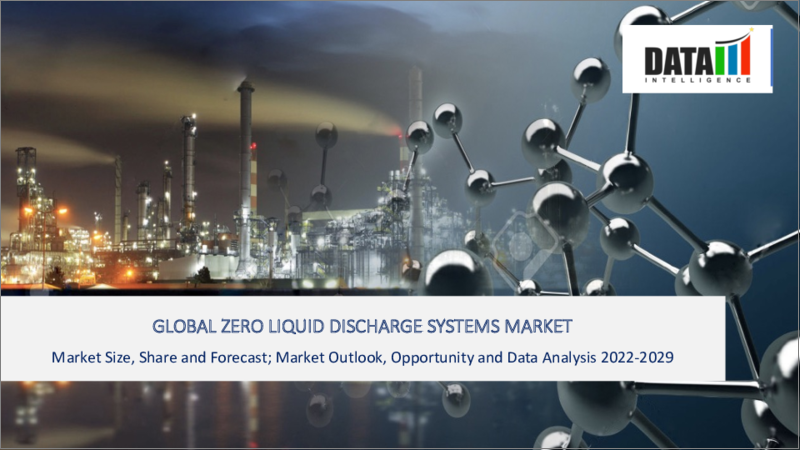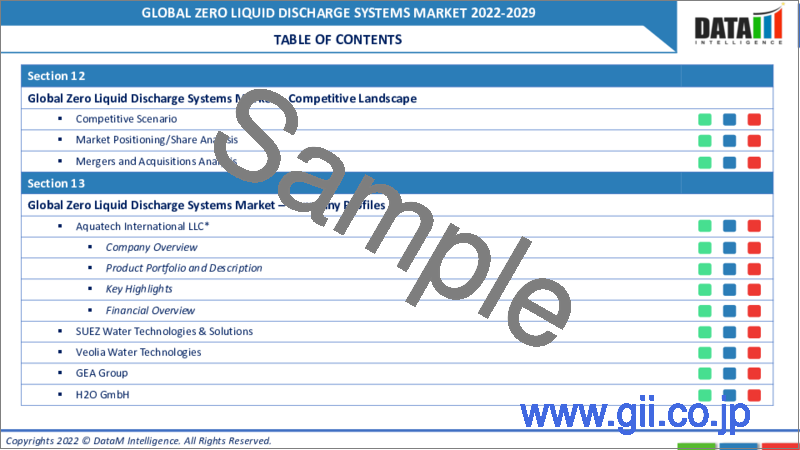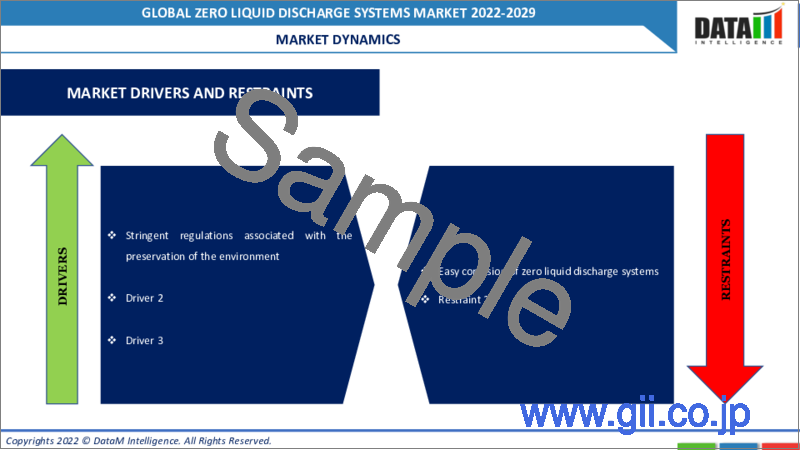|
|
市場調査レポート
商品コード
1078242
ゼロ排水システムの世界市場(2022年~2029年)Global Zero Liquid Discharge Systems Market - 2022-2029 |
||||||
|
● お客様のご希望に応じて、既存データの加工や未掲載情報(例:国別セグメント)の追加などの対応が可能です。 詳細はお問い合わせください。 |
|||||||
| ゼロ排水システムの世界市場(2022年~2029年) |
|
出版日: 2022年05月25日
発行: DataM Intelligence
ページ情報: 英文 204 Pages
納期: 約2営業日
|
- 全表示
- 概要
- 目次
当レポートでは、世界のゼロ排水システム市場を調査しており、市場の概要、市場規模や予測、動向、成長要因および課題、顧客情勢、システム・技術・プロセス・エンドユーザー・地域別の分析、さら企業プロファイルなどを提供しています。
目次
第1章 世界のゼロ排水システム市場:調査手法と範囲
- 調査手法
- 調査の目的と調査範囲
第2章 世界のゼロ排水システム市場:市場の定義と概要
第3章 世界のゼロ排水システム市場:エグゼクティブサマリー
- システム別の市場内訳
- 技術別の市場内訳
- プロセス別の市場内訳
- エンドユーザー別の市場内訳
- 地域別の市場内訳
第4章 世界のゼロ排水システム市場:市場力学
- 市場に影響を与える要因
- 促進要因
- 抑制要因
- 市場機会
- 影響分析
第5章 世界のゼロ排水システム市場:業界分析
- ポーターのファイブフォース分析
- サプライチェーン分析
- 価格分析
- 規制分析
第6章 世界のゼロ排水システム市場:COVID-19分析
- 市場へのCOVID-19の影響分析
- COVID-19前の市場シナリオ
- 現在のCOVID-19市場シナリオ
- COVID-19後または将来のシナリオ
- COVID-19における価格変動
- 需要と供給のスペクトル
- パンデミック時の市場に関連する政府のイニシアチブ
- メーカーの戦略的イニシアチブ
- 結論
第7章 世界のゼロ排水システム市場:システム別
- イントロダクション
- システム別の市場規模分析、および前年比成長分析
- システム別の市場魅力指数
- 従来型
- イントロダクション
- 市場規模分析、および前年比成長分析
- ハイブリッド
第8章 世界のゼロ排水システム市場:技術別
- イントロダクション
- 技術別の市場規模分析、および前年比成長分析
- 技術別の市場魅力指数
- 熱ベース
- イントロダクション
- 市場規模分析、および前年比成長分析
- 膜ベース
第9章 世界のゼロ排水システム市場:プロセス別
- イントロダクション
- プロセス別の市場規模分析、および前年比成長分析
- プロセス別の市場魅力指数
- 前処理
- イントロダクション
- 市場規模分析、および前年比成長分析
- ろ過/膜ろ過
- 蒸発・結晶化
- 固体/塩の回収
第10章 世界のゼロ排水システム市場:エンドユーザー別
- イントロダクション
- エンドユーザー別の市場規模分析、および前年比成長分析
- エンドユーザー別の市場魅力指数
- エネルギー・電力
- イントロダクション
- 市場規模分析、および前年比成長分析
- 化学薬品・石油化学製品
- 食品・飲料
- テキスタイル
- 医薬品
- その他
第11章 世界のゼロ排水システム市場:地域別
- イントロダクション
- 地域別の市場規模分析、および前年比成長分析
- 地域別の市場魅力指数
- 北米
- イントロダクション
- 主要な地域固有のダイナミクス
- システム別の市場規模分析、および前年比成長分析
- 技術別の市場規模分析、および前年比成長分析
- プロセス別の市場規模分析、および前年比成長分析
- エンドユーザー別の市場規模分析、および前年比成長分析
- 国別の市場規模分析、および前年比成長分析
- 欧州
- イントロダクション
- 主要な地域固有のダイナミクス
- システム別の市場規模分析、および前年比成長分析
- 技術別の市場規模分析、および前年比成長分析
- プロセス別の市場規模分析、および前年比成長分析
- エンドユーザー別の市場規模分析、および前年比成長分析
- 国別の市場規模分析、および前年比成長分析
- 南米
- イントロダクション
- 主要な地域固有のダイナミクス
- システム別の市場規模分析、および前年比成長分析
- 技術別の市場規模分析、および前年比成長分析
- プロセス別の市場規模分析、および前年比成長分析
- エンドユーザー別の市場規模分析、および前年比成長分析
- 国別の市場規模分析、および前年比成長分析
- アジア太平洋
- イントロダクション
- 主要な地域固有のダイナミクス
- システム別の市場規模分析、および前年比成長分析
- 技術別の市場規模分析、および前年比成長分析
- プロセス別の市場規模分析、および前年比成長分析
- エンドユーザー別の市場規模分析、および前年比成長分析
- 国別の市場規模分析、および前年比成長分析
- 中東とアフリカ
- イントロダクション
- 主要な地域固有のダイナミクス
- システム別の市場規模分析、および前年比成長分析
- 技術別の市場規模分析、および前年比成長分析
- プロセス別の市場規模分析、および前年比成長分析
- エンドユーザー別の市場規模分析、および前年比成長分析
第12章 世界のゼロ排水システム市場:競合情勢
- 競合シナリオ
- 市場ポジショニング/シェア分析
- 合併と買収の分析
第13章 世界のゼロ排水システム市場:企業プロファイル概要
- Aquatech International LLC
- 企業概要
- 製品ポートフォリオ・種類
- 主要ハイライト
- 財務概要
- SUEZ Water Technologies & Solutions
- Veolia Water Technologies
- GEA Group
- H2O GmbH
- US Water Services
- Aquarion AG
- Doosan Hydro Technology LLC
- Petro Sep Corporation
- IDE Technologies
第14章 世界のゼロ排水システム市場:重要考察
第15章 世界のゼロ排水システム市場:DataM
- 付録
- 当社・サービスについて
- お問い合わせ
Market Overview
The global zero liquid discharge systems market reached US$ XX million in 2021 and is expected to reach US$ XX million by 2029, growing at a CAGR of XX% during the forecast period 2022-2029.
The term "zero liquid discharge" (ZLD) refers to a treatment procedure in which the plant discharges no liquid effluent into surface waterways, effectively removing all treatment-related contamination. All water is collected and impurities are converted to solid waste in a zero liquid discharge (ZLD) approach to water treatment. While many water treatment methods aim to maximize freshwater recovery while minimizing waste, ZLD is the most difficult to achieve. The expense and difficulty of recovery rise as the wastewater become more concentrated. Salinity, scaling chemicals and organics all have higher concentrations, which adds to the costs of handling them. ZLD is done by connecting water treatment technologies to treat wastewater as contaminants become more concentrated.
Aside from this advantage, a ZLD process makes efficient use of wastewater treatment, recycling and reuse, contributing to water conservation by reducing the amount of freshwater consumed.
Market Dynamics
Stringent regulations associated with the preservation of the environment act as a major market driver. Nonetheless, widespread corrosion of zero liquid discharge systems could be considered a major market restraint.
Stringent regulations associated with the preservation of the environment
In a world where fresh water is a more valuable resource, industrial activity risks its availability on two fronts unless the water is cleaned. Many industrial processes demand water, reducing the amount of water available for the environment or other uses, or polluting and releasing water that affects the ecosystem. ZLD systems are mostly used in the industrial sector, as these are the sources of the majority of hazardous emissions to water bodies and aquatic ecosystems. Mercury, arsenic, lead, selenium, salt, toxic elements, nitrate and other pollutants contribute to ecosystem imbalance.
Although wastewater discharge restriction's history can be traced back to the Clean Water Act of 1972 enacted by the government of U.S., India and China, have been at the forefront of the zero liquid discharge movement in the last decade. Both countries have enacted laws requiring zero liquid discharge because of the widespread poisoning of multiple significant rivers by industrial effluent.
Since modernity discovered that protecting rivers and lakes from pollution is the most effective way to safeguard future water supply and high costs of wastewater disposal at inland plants have propelled the goal toward zero liquid discharge in Europe and North America. Regulations that limit disposal alternatives and factors impacting the expense of disposal technologies drive these costs.
As the serious repercussions of water pollution become more widely recognized and public attention grows, stricter environmental rules on wastewater discharge are likely, pushing more high-polluting sectors toward ZLD. Therefore the imposed requirements on industry and power plants regulating emissions in water bodies are a primary element driving market growth for zero liquid discharge systems.
Easy corrosion of zero liquid discharge systems
Corrosion at particular stages of the ZLD process, such as crystallization and dewatering, is a major cause and has critical effects on the ZLD systems. For instance, when the remaining liquor or brine contains higher salt concentrations, it might cause a failure in the pipes or other mechanical portions of the system. Similarly, spray driers can sometimes aid by offsetting the solubility of certain salts. Scale building can also lead to corrosion and a loss of heat transfer; therefore, many of the contaminants that can lead to corrosion in the ZLD process's thermal parts must be treated on a case-by-case basis. Chemical balance, concentrations, heat level and pressure are all factors that go into this complicated computation.
Since ZLD is a complex process involving exorbitant and large equipment, the ease at which these equipment corrode seriously impacts the market as it puts millions of dollars at stake. Though corrosion-resistant building materials like nickel- and titanium-based alloys could widely be employed to prevent corrosion, the respective metals are more expensive than standard materials employed in manufacturing ZLD systems. The utilization of these expensive metals could increase the manufacturing costs involved with ZDL equipment and thereby affect the product's final price. As a result, the ZLD systems' corrosion could be recognized as a major market restraint.
COVID-19 Impact Analysis
COVID-19 resulted in a dramatic reduction in the number of ZDL systems being purchased. Furthermore, the pandemic posed other obstacles, including halting manufacturing and generating delays in shipments due to supply chain bottlenecks.
COVID-19 has considerably impacted manufacturing industries such as oil and gas, mining and capital goods. Heavy industry, the end-user, was hurt the hardest because of its extensive supply chains, labor-intensive operations and interdependencies due to division of labor, modular production processes and outsourcing to reduce costs and increase efficiency, consistency and quality of each operation.
Nonetheless, the global zero liquid discharge systems market has high market prospects in the future because of the growing environmental awareness among consumers that promotes stringent environmental regulations, as well as companies widely adopting a sustainable approach.
Segment Analysis
The global zero liquid discharge systems market is classified based on system, technology, process, end-user and region
The energy & power sector dominates the end-user segment
The zero liquid discharge systems market's end-user segment consists of energy & power, chemicals & petrochemicals, food & beverage, textiles, pharmaceuticals and others. Globally, rising population combined with growing urbanization has resulted in increased energy demand. As a result, more industries and power plants have been built. The most common application of ZLD is in thermal power plants. Thermal power plants continue to provide a significant share of energy and this aspect is likely driving ZLD installations in the industry. Power & energy is one of the most water-intensive industries on the planet. As a result of changing restrictions surrounding wastewater discharge and freshwater scarcity, demand for ZLD and high water recovery solutions is increasing.
Geographical Analysis
North America is expected to dominate the zero liquid discharge systems market's regional segment
During the projected period, North America will have the greatest zero liquid discharge market share and will dominate the zero liquid discharge systems market because of the progressive increase in population and industry, as well as an increase in water and sewage treatment facilities.
U.S. is a country with strict rules on wastewater emissions, which supports the market's regional expansion. U.S.'s Environmental Protection Agency (EPA) recently completed its recommendations, amending its existing wastewater standards. The new standards establish federal limitations on hazardous metals and other wastes, making ZLD the preferable remedy for contaminants in fly ash transport water, ash transport water and flue gas mercury wastewater. In addition, the government will provide regulatory incentives for ZLD installations in power plants in U.S.
Competitive Landscape
The global zero liquid discharge systems market is active and dynamic in terms of the number and strength of global and local producers. Due to many manufacturers such as Aquatech International LLC, SUEZ Water Technologies & Solutions, Veolia Water Technologies, GEA Group, H2O GmbH, US Water Services, Aquarion AG, Doosan Hydro Technology LLC, Petro Sep Corporation and IDE Technologies, the market is classified as fragmented. To achieve competitive advantages and recognition in their particular markets, significant market stakeholders use market techniques such as mergers, acquisitions, product launches, contributions and collaborations.
For instance, on April 09, 2018, Fluence Corporation Limited announced that its customer Rosenblad Design Group had awarded them a contract to deliver a water treatment reuse system. Fluence's zero liquid discharge (ZLD) solution will treat brine for reuse with ultrafiltration and reverse osmosis equipment. The system will be integrated and used as part of a larger turnkey water treatment project installed by Rosenblad in California, one of Fluence's main water and wastewater treatment markets.
Aquatech International, LLC
Overview: Aquatech International, LLC focuses on the commercial and service industry machinery manufacturing industry and is based in Pennsylvania, U.S. The Aquatech International, LLC corporate family consists of 30 entities, employs 500 people and generated US$86.53 million in revenue across all of its locations globally.
Product Portfolio:
R3MOD: R3MOD is mainly composed of an effective softening/heavy metals removal pretreatment (CeraSoft), ultrahigh recovery Reverse Osmosis (ARROTM) and a proprietary high-flux membrane distillation process (AVMDTM). The respective product line consists of highly differentiated unit operations and is designed to integrate and significantly reduce the cost of ownership for small/mid-sized ZLD and MLD plants by up to 40%.
Key Development:
On April 04, 2019, Aquatech International LLC completed the manufacture of a "first of its kind" membrane-thermal ZLD project for Continental Gold, a mining corporation, for its gold mine located in the village of Buritica, northwestern Colombia.
Why Purchase the Report?
To visualize the global zero liquid discharge systems market segmentation based on system, technology, process, end-user and region, as well as understand key commercial assets and players.
Identify commercial opportunities in the global zero liquid discharge systems market by analyzing trends and co-development.
Excel data sheet with numerous data points of zero liquid discharge systems market-level with four segments.
PDF report consisting of cogently put together market analysis after exhaustive qualitative interviews and in-depth market study.
Product mapping available as excel consists of key products of all the major market players
The global zero liquid discharge systems market report would provide approximately 69 tables, 67 figures and almost 204 pages.
Target Audience 2023
Manufacturers/ Buyers
Industry Investors/Investment Bankers
Research Professionals
Emerging Companies
Table of Contents
1. Global Zero Liquid Discharge Systems Market - Methodology and Scope
- 1.1. Research Methodology
- 1.2. Research Objective and Scope of the Report
2. Global Zero Liquid Discharge Systems Market - Market Definition and Overview
3. Global Zero Liquid Discharge Systems Market - Executive Summary
- 3.1. Market Snippet by System
- 3.2. Market Snippet by Technology
- 3.3. Market Snippet by Process
- 3.4. Market Snippet by End-User
- 3.5. Market Snippet by Region
4. Global Zero Liquid Discharge Systems Market-Market Dynamics
- 4.1. Market Impacting Factors
- 4.1.1. Drivers
- 4.1.1.1. Stringent regulations associated with the preservation of the environment
- 4.1.1.2. XX
- 4.1.2. Restraints
- 4.1.2.1. Easy corrosion of zero liquid discharge systems
- 4.1.2.2. XX
- 4.1.3. Opportunity
- 4.1.3.1. XX
- 4.1.4. Impact Analysis
- 4.1.1. Drivers
5. Global Zero Liquid Discharge Systems Market - Industry Analysis
- 5.1. Porter's Five Forces Analysis
- 5.2. Supply Chain Analysis
- 5.3. Pricing Analysis
- 5.4. Regulatory Analysis
6. Global Zero Liquid Discharge Systems Market - COVID-19 Analysis
- 6.1. Analysis of COVID-19 on the Market
- 6.1.1. Before COVID-19 Market Scenario
- 6.1.2. Present COVID-19 Market Scenario
- 6.1.3. After COVID-19 or Future Scenario
- 6.2. Pricing Dynamics Amid COVID-19
- 6.3. Demand-Supply Spectrum
- 6.4. Government Initiatives Related to the Market During Pandemic
- 6.5. Manufacturers Strategic Initiatives
- 6.6. Conclusion
7. Global Zero Liquid Discharge Systems Market - By System
- 7.1. Introduction
- 7.1.1. Market Size Analysis and Y-o-Y Growth Analysis (%), By System
- 7.1.2. Market Attractiveness Index, By System
- 7.2. Conventional*
- 7.2.1. Introduction
- 7.2.2. Market Size Analysis and Y-o-Y Growth Analysis (%)
- 7.3. Hybrid
8. Global Zero Liquid Discharge Systems Market - By Technology
- 8.1. Introduction
- 8.1.1. Market Size Analysis and Y-o-Y Growth Analysis (%), By Technology
- 8.1.2. Market Attractiveness Index, By Technology
- 8.2. Thermal Based*
- 8.2.1. Introduction
- 8.2.2. Market Size Analysis and Y-o-Y Growth Analysis (%)
- 8.3. Membrane Based
9. Global Zero Liquid Discharge Systems Market - By Process
- 9.1. Introduction
- 9.1.1. Market Size Analysis and Y-o-Y Growth Analysis (%), By Process
- 9.1.2. Market Attractiveness Index, By Process
- 9.2. Pretreatment*
- 9.2.1. Introduction
- 9.2.2. Market Size Analysis and Y-o-Y Growth Analysis (%)
- 9.3. Filtration/Membrane Filtration
- 9.4. Evaporation & Crystallization
- 9.5. Solid/Salt Recovery
10. Global Zero Liquid Discharge Systems Market - By End-User
- 10.1. Introduction
- 10.1.1. Market Size Analysis and Y-o-Y Growth Analysis (%), By End-User
- 10.1.2. Market Attractiveness Index, By End-User
- 10.2. Energy & Power*
- 10.2.1. Introduction
- 10.2.2. Market Size Analysis and Y-o-Y Growth Analysis (%)
- 10.3. Chemicals & Petrochemicals
- 10.4. Food & Beverage
- 10.5. Textiles
- 10.6. Pharmaceuticals
- 10.7. Others
11. Global Zero Liquid Discharge Systems Market - By Region
- 11.1. Introduction
- 11.1.1. Market Size Analysis and Y-o-Y Growth Analysis (%), By Region
- 11.1.2. Market Attractiveness Index, By Region
- 11.2. North America
- 11.2.1. Introduction
- 11.2.2. Key Region-Specific Dynamics
- 11.2.3. Market Size Analysis and Y-o-Y Growth Analysis (%), By System
- 11.2.4. Market Size Analysis and Y-o-Y Growth Analysis (%), By Technology
- 11.2.5. Market Size Analysis and Y-o-Y Growth Analysis (%), By Process
- 11.2.6. Market Size Analysis and Y-o-Y Growth Analysis (%), By End-User
- 11.2.7. Market Size Analysis and Y-o-Y Growth Analysis (%), By Country
- 11.2.7.1. U.S.
- 11.2.7.2. Canada
- 11.2.7.3. Mexico
- 11.3. Europe
- 11.3.1. Introduction
- 11.3.2. Key Region-Specific Dynamics
- 11.3.3. Market Size Analysis and Y-o-Y Growth Analysis (%), By System
- 11.3.4. Market Size Analysis and Y-o-Y Growth Analysis (%), By Technology
- 11.3.5. Market Size Analysis and Y-o-Y Growth Analysis (%), By Process
- 11.3.6. Market Size Analysis and Y-o-Y Growth Analysis (%), By End-User
- 11.3.7. Market Size Analysis and Y-o-Y Growth Analysis (%), By Country
- 11.3.7.1. Germany
- 11.3.7.2. UK
- 11.3.7.3. France
- 11.3.7.4. Italy
- 11.3.7.5. Russia
- 11.3.7.6. Rest of Europe
- 11.4. South America
- 11.4.1. Introduction
- 11.4.2. Key Region-Specific Dynamics
- 11.4.3. Market Size Analysis and Y-o-Y Growth Analysis (%), By System
- 11.4.4. Market Size Analysis and Y-o-Y Growth Analysis (%), By Technology
- 11.4.5. Market Size Analysis and Y-o-Y Growth Analysis (%), By Process
- 11.4.6. Market Size Analysis and Y-o-Y Growth Analysis (%), By End-User
- 11.4.7. Market Size Analysis and Y-o-Y Growth Analysis (%), By Country
- 11.4.7.1. Brazil
- 11.4.7.2. Argentina
- 11.4.7.3. Rest of South America
- 11.5. Asia-Pacific
- 11.5.1. Introduction
- 11.5.2. Key Region-Specific Dynamics
- 11.5.3. Market Size Analysis and Y-o-Y Growth Analysis (%), By System
- 11.5.4. Market Size Analysis and Y-o-Y Growth Analysis (%), By Technology
- 11.5.5. Market Size Analysis and Y-o-Y Growth Analysis (%), By Process
- 11.5.6. Market Size Analysis and Y-o-Y Growth Analysis (%), By End-User
- 11.5.7. Market Size Analysis and Y-o-Y Growth Analysis (%), By Country
- 11.5.7.1. China
- 11.5.7.2. India
- 11.5.7.3. Japan
- 11.5.7.4. Australia
- 11.5.7.5. Rest of Asia-Pacific
- 11.6. Middle East and Africa
- 11.6.1. Introduction
- 11.6.2. Key Region-Specific Dynamics
- 11.6.3. Market Size Analysis and Y-o-Y Growth Analysis (%), By System
- 11.6.4. Market Size Analysis and Y-o-Y Growth Analysis (%), By Technology
- 11.6.5. Market Size Analysis and Y-o-Y Growth Analysis (%), By Process
- 11.6.6. Market Size Analysis and Y-o-Y Growth Analysis (%), By End-User
12. Global Zero Liquid Discharge Systems Market - Competitive Landscape
- 12.1. Competitive Scenario
- 12.2. Market Positioning/Share Analysis
- 12.3. Mergers and Acquisitions Analysis
13. Global Zero Liquid Discharge Systems Market- Company Profiles
- 13.1. Aquatech International LLC*
- 13.1.1. Company Overview
- 13.1.2. Product Portfolio and Description
- 13.1.3. Key Highlights
- 13.1.4. Financial Overview
- 13.2. SUEZ Water Technologies & Solutions
- 13.3. Veolia Water Technologies
- 13.4. GEA Group
- 13.5. H2O GmbH
- 13.6. US Water Services
- 13.7. Aquarion AG
- 13.8. Doosan Hydro Technology LLC
- 13.9. Petro Sep Corporation
- 13.10. IDE Technologies
LIST NOT EXHAUSTIVE
14. Global Zero Liquid Discharge Systems Market - Premium Insights
15. Global Zero Liquid Discharge Systems Market - DataM
- 15.1. Appendix
- 15.2. About Us and Services
- 15.3. Contact Us




